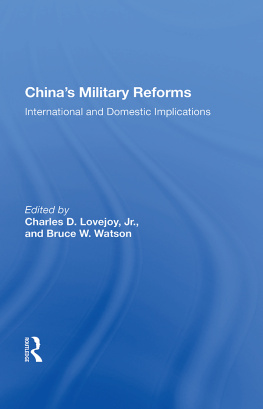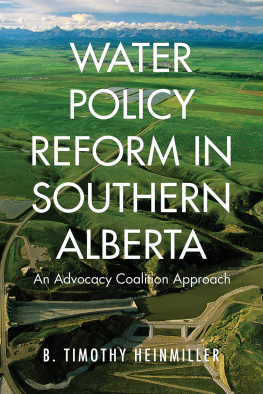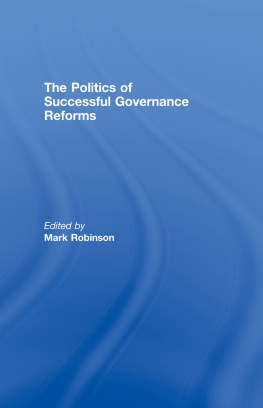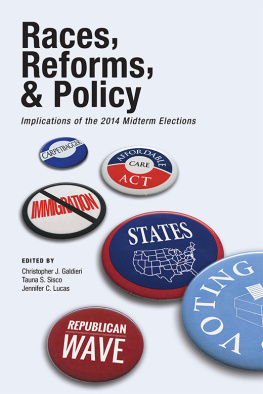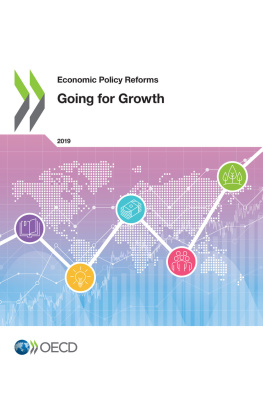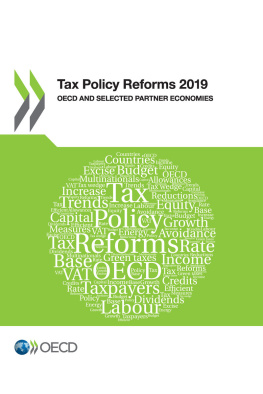
REFORMS AT RISK
PRINCETON STUDIES IN AMERICAN POLITICS:
HISTORICAL, INTERNATIONAL, AND COMPARATIVE PERSPECTIVES
Ira Katznelson, Martin Shefter, and Theda Skocpol, eds.
A list of titles in this series appears at the back of the book
REFORMS AT RISK:
WHAT HAPPENS AFTER MAJOR POLICY CHANGES ARE ENACTED
Eric M. Patashnik
PRINCETON UNIVERSITY PRESS
PRINCETON AND OXFORD
Copyright 2008 by Princeton University Press
Published by Princeton University Press, 41 William Street, Princeton, New Jersey 08540
In the United Kingdom: Princeton University Press, 6 Oxford Street, Woodstock, Oxfordshire OX20 1TW
All Rights Reserved
Library of Congress Cataloging-in-Publication Data
Patashnik, Eric M.
Reforms at risk : what happens after major policy changes are enacted / Eric M. Patashnik.
p. cm. (Princeton studies in American politics)
Includes bibliographical references and index.
ISBN 978-0-691-11998-4 (hardcover : alk. paper) ISBN 978-0-691-13897-8 (pbk. : alk. paper) 1. Political planningUnited States. I. Title.
JK468.P64P38 2008
320.60973dc22 2008005148
British Library Cataloging-in-Publication Data is available
This book has been composed in Goudy
Printed on acid-free paper.
press.princeton.edu
Printed in the United States of America
10 9 8 7 6 5 4 3 2 1
For Debbie
Contents
List of Figures and Tables
FIGURES
TABLES
Acknowledgments
T HIS PROJECT EXAMINES the political sustainability of domestic policy reforms. It explores why some reforms succeed and others unravel after they become law. This question has received surprisingly little attention. Most scholars and journalists have focused far more on the adoption of reforms than on their unfolding policy development. Yet the political aftermath of reform is no less interesting or important than the dramatic moment of enactment. If my book has a simple message, it is that even the most solid reform ideas require ongoing collective support to endure, but such support is not always provided. When it does come, it should never be taken for granted. I hope the ideas contained in this book will prove useful to scholars, policymakers, advocates, and journalists. If they do, it will be because of the considerable support I have received from a large number of individuals and institutions. Truly, they sustained me over the life of this project.
My research was supported by fellowships from the UCLA Center for American Politics and Public Policy, the Smith Richardson Foundation, the Earhart Foundation, and the D&D Foundation. Special thanks to Kim Dennis, Mark Steinmeyer, Joel Aberbach, and Barbara Nelson for their support on this project. I received outstanding research assistance from several University of Virginia graduate students, including Anne Peters, Justin Peck, and Hilde Eliassen Restad. Seminar audiences at Yale University, William and Mary, and Georgetown University provided great comments and suggestions. I have also benefited enormously from my participation over the years in various new politics of public policy conferences organized by Martin A. Levin, Marc K. Landy, and Martin Shapiro at Brandeis University and Boston College. I am very grateful for their support, as well as for the feedback I received from other scholars who have participated in these conferences and book projects, especially Eugene Bardach, Jacob Hacker, Alan Jacobs, Jonathan Macey, Christopher Howard, and Peter Schuck. I also appreciate the encouragement I have received for this project from Paul Pierson and Paul J. Quirk.
Julian Zelizer and Steven Teles read early drafts of the entire manuscript and provided many helpful suggestions. Many qualitative studies in political science explore a single policy episode or sector in depth, but I believed it was necessary to examine reform trajectories across a fairly large number of arenas to identify more general patterns of policy development. The challenge was to keep my larger themes in focus without making a hash of the individual cases. I am fortunate that a number of policy experts were willing to take the time to give me detailed comments on specific case-study chapters. I wish to thank Dallas Burtraw, William Gale, Bruce Gardner, Darius W. Gaskins, Jr., Donald F. Kettl, Michael E. Levine, David Orden, Eugene Steuerle, John Witte, James Wooten, and George Yin for sharing their insights. I hasten to add that I alone am responsible for any errors of fact or interpretation. I also wish to thank the many congressional staff members, policy practitioners, and journalists who were willing to be interviewed about these reform episodes.
I appreciate the intellectual and professional support I have received from my University of Virginia colleagues, including Herman Schwartz, Gerard Alexander, Sid Milkis, James Ceaser, James Savage, David Breneman, Jeff Legro, Jeffrey Jenkins, and especially Martha Derthick, whose superb book (with Paul J. Quirk) The Politics of Deregulation helped motivate this study. Marylynn Sergent, Steve Morrison, Bruce Gardner, and other individuals I fear I have forgotten to name, generously provided data or factual information.
I received extremely helpful feedback from two anonymous reviewers for Princeton University Press. I also wish to express my deep appreciation to my editor, Chuck Myers, for patiently supporting this project from concept to completion. Portions of this book appeared in very different forms in two previous essays: After the Public Interest Prevails: The Political Sustainability of Policy Reform, Governance, (April 2003): 20334 and The Day After Market-Oriented Reform; or What Happens When Economists Reform Ideas Meet Politics, in Creating Competitive Markets: The Politics and Economics of Regulatory Reform, Marc K. Landy, Martin A. Levin, and Martin Shapiro, eds., (Brookings Institution Press, 2007), 167289.
Finally, I wish to thank my family. My wonderful sons Michael and Josh have provided a steady stream of good-natured distractions and fun. My parents, Anne and Bernard Patashnik, my grandmother, Bertha Rosenblatt, and my brother David Patashnik have all been very supportive. This book is dedicated to my amazing wife Deborah Gordon. A book project is all-consuming. I am fortunate to have a wife who is not only my best friend, but a professional policy analyst who does not mind discussing an unromantic topic like emissions trading over a candlelight dinner. Debbie suggested the books title, helped me create some of the graphs, and proofread the manuscript. She always seemed to know when to give me a well-deserved kick to motivate me to write another few pages before calling it a dayand when to nudge me away from the computer to take a much-needed coffee break or family walk. I am one lucky guy.
REFORMS AT RISK
CHAPTER 1
Introduction: General-Interest Policymaking and the Politics of Reform Sustainability
To innovate is not to reform.
Edmund Burke
There is nothing more difficult to carry out, nor more doubtful of success, nor more dangerous to handle, than to institute a new order of things.
Niccolo Machiavelli
The most dangerous moment for a bad government is when it begins to reform.
Alexis de Tocqueville
O N O CTOBER 22, 1986, lawmakers from both parties gathered on the South Lawn of the White House and applauded as President Ronald Reagan signed into law the most comprehensive revision of the federal tax code in a half century. The landmark Tax Reform Act of 1986 eliminated or curtailed dozens of shelters, loopholes, and other tax breaks enjoyed by powerful corporations and well-heeled investors. By withdrawing tax preferences from a favored few, the federal government was able to sharply lower tax rates for millions of low- and middle-income Americans without increasing the federal budget deficit. While the tax reform law was not flawless, it made the federal tax system fairer and more efficient. At the signing ceremony, Reagan called the Tax Reform Act the best antipoverty bill, the best pro-family measure, and the best job-creation program ever to come out of the Congress of the United States. At last. Its a day to stop and take unashamed satisfaction in a triumph of the whole over the parts, editorialized
Next page



